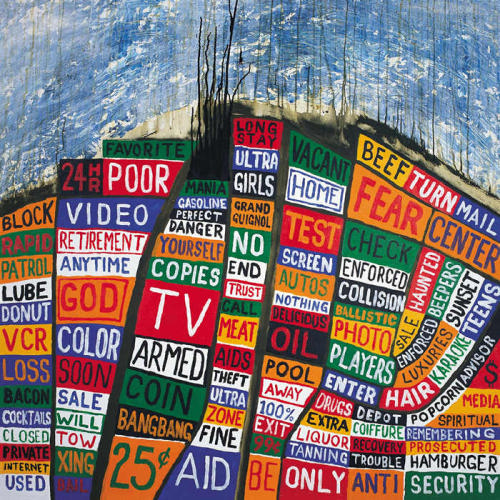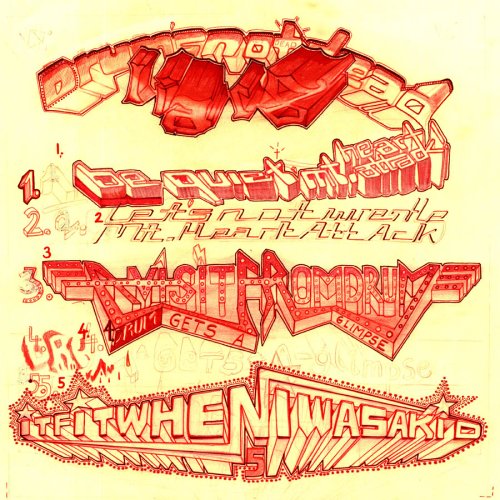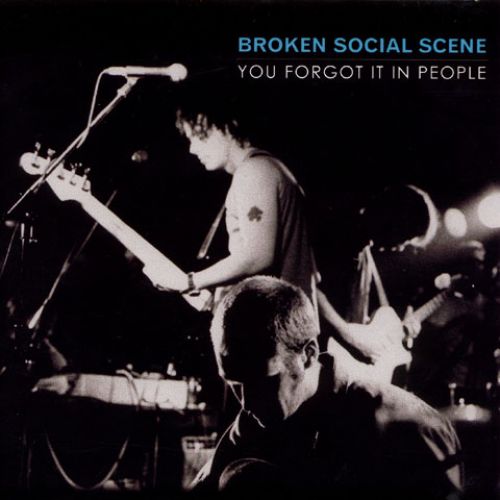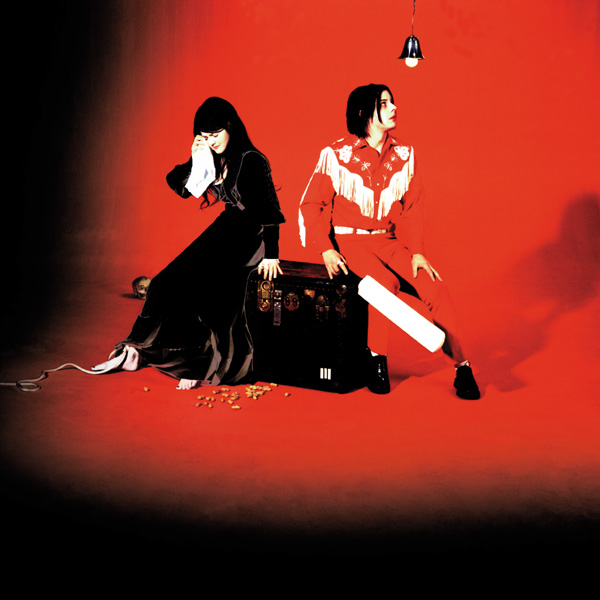
30.
Radiohead
Hail to the Thief
[Parlophone / Capitol; 2003]
Let’s address the elephant in the room: Hail to the Thief isn’t many people’s favourite Radiohead album, nor is it mine. But while it lacks the situational experimental flow of Kid A or the neurotic glaring buzz of OK Computer, it offers a cohesive variety and acts as a grand enough statement to not be whisked aside. Even though Thom Yorke sounds human again he still sounds confused, angry and paranoid while Johnny Greenwood releases twitches of frantic instrumentation from the unhinged guitar solo on “Go To Sleep” to the heavy erratic drone of “Myxomatosis.” Hail to the Thief sounds like an attack if anything. Who it’s directed at is subjective and open to much interpretation but in carrying it out they prove their skills as excellent musicians who have lasted their legacy (and beyond).
But as much as people will define this album as a “collection of tracks” as opposed to a structured whole, it still has the attributes of any great Radiohead album. There’s the brilliant opening and closing tracks (“2 + 2 = 5” explodes and fuses together complex time signatures while “Wolf At The Door” has Thom Yorke sputtering his lyrics like he’s captured in some deranged episode), it has a masterful centrepiece (“Where You End And I Begin” even has the doubters slayed once that guitar comes in at the two minute mark) and there’s also the experimental side flowing through it (“Backdrifts” stutters by on a cloud of uncertain noise while the percussion on “There There” is still something the band aren’t likely to top as far as I’m concerned). And all in the middle, a rare moment: “We Suck Young Blood” shows that the band can poke fun at themselves and still enjoy the process. Hail to the Thief might well be just the collection of tracks that everyone describes it as, the band offering a piece of everything to please everyone. But really they sound like they’re pleasing themselves first and for a band that many obsess furiously over regarding the concept of “the album” it’s just nice to hear a great band play some great songs.
– Ray Finlayson

29.
Sufjan Stevens
Illinois
[Asthmatic Kitty; 2005]
One thing you can’t deny about Illinois is that it’s huge. Listening to the whole thing in one sitting is still a slightly daunting task. But Illinois is a pretty damn big state (57,918 square miles, in fact). The length of the album is justified. However, this isn’t the whole of Illinois captured. Rather, it’s Sufjan’s own experience of it from relationships he had while living there, dreams of Carl Sandberg, his fascination with child killer John Wayne Gacy Jr and probably about a million other things (“I said things I meant to say”). This doesn’t matter though, because his experience is good enough to convince me that I’ve lived there myself at some point in my life or at least I was living with him. He weaves delicate pictures of the smallest details with ideas that have lasted the ages through history. But it’s his style which is most significant here; even though the album is full of fanfare, shrill choirs and huge orchestra arrangements, Sufjan still holds true to his folksy roots, juxtaposing those aforementioned styles with soft acoustic moments but packing every minute with detail, showcasing his impressive and graciously witty literary prowess. Illinois might just be the sound of one state, but it’s packed with a world’s worth of material.
– Ray Finlayson

28.
The National
Alligator
[Beggars Banquet; 2005]
I once feebly asked the question of how the members of The National could sleep at night when they have created an album like Alligator? The answer is simple: they manage to sleep because they are humans and like every other one they need sleep to recuperate and give them energy. But I bet Matt Berninger still wakes up pissed off and suffering an existential crisis. Whether he’s just looking for simple recognition from his boss on “Baby, We’ll Be Fine” or posing as a protesting evangelist on “All The Wine” (“I’m so sorry but the motorcade will have to around me this time/cause God is on my side”), he sounds like a man looking for meaning in every action he makes, both big and small. Even if the characters (or characterisations) portrayed are fictional and temporary he will still occupy the space in their heads and do so with distinct passion, yearning for purpose. Like the album title suggests, this body of work can be solemn and still at one point and then be a vicious monster the next. It takes some taming to get to grips with fully, but you’ll happily lose sleep over doing so.
– Ray Finlayson

27.
Liars
Drum’s Not Dead
[Mute; 2006]
Liars are a band that don’t conform to expectations. In fact, they haven’t really conformed to any established convention of what a band is supposed to do. Launching with a hotly tipped debut in the heat of the “dancepunk” movement, they followed it up with something completely different, and were panned across the board. Then they ran away to Berlin and came up with…this. No punk, no dance, hardly any rock. Legend goes they recorded the album in an old East German radio tower, exploring the acoustics of various rooms, and that’s exactly what Drum’s Not Dead sounds like. Every song feels like it was recorded in its own room, each a subtle variation on a distinct sound, with the same ineffable “instruments” but different effects and experiments.
It’s hard to say if this is a noise record, a drone record, or whatever other marginal genre tags that might apply. It dabbles in all sorts of the outer fringes of Western music, but doesn’t fully commit to any of them. There are plenty of noisy, distorted elements, quite a few repetitive, industrial passages, and some beautiful, anthemic ballads. Despite the similar instrumental makeup of some of these songs, each one has a completely different sound palette, united by the album’s unique aesthetic; the digeridoo on “Let’s Not Wrestle Mt. Heart Attack,” the unnerving organ on “It Fit When I Was A Kid,” or the brushed, jazzy drums and carnivalesque tinkles on “The Wrong Coat For You, Mt. Heart Attack” (a track that easily sounds like it could have been recorded in the mid-’60s), it somehow all manages to make for one really cohesive listen. With stunning closer “The Other Side of Mt. Heart Attack” they even find a way to calm you down and get you out of that labrynthine radio tower.
– Andrew Ryce

26.
Broken Social Scene
You Forgot It in People
[Arts & Crafts / Paper Bag; 2002]
Looking back at the list of contributors to 2002’s You Forgot It in People it’s difficult to believe that this is the album that ‘broke’ so many great names in the Canadian music scene — Leslie Feist, Emily Haines, to name a few. Nowadays, the band is considered an all star collaboration of Canada’s finest, but after You Forgot It in People was released, none of the members had really solidified themselves outside the collective.
You Forgot It in People introduced the indie world to a very particular brand of baroque pop. Rarely does a band come around that is capable of squeezing a multitude of sounds and instruments into each track (sometimes in conflict with each other) and somehow manage creating one beautiful, cohesive final product. Part of the brilliance of that sound was the band’s realization that the voice is just another instrument — and so it gets mixed at the same levels as the others. This technique allows for a rich experience, as each listen allows further clarification and understanding of each layer so meticulously included on each track.
Perhaps the album’s greatest strength is its ability to juxtapose upbeat rock (Almost Crimes, Cause = Time) with achingly beautiful songs of heartbreak (Anthem for a Seventeen-Year Old Girl, Lover’s Spit, I’m Still Your Fag). While the band would follow up this record with indie pop gems like “7/4 Shoreline” and “It’s All Gonna Break,” they may never achieve the heartfelt catharsis listeners can find in listening to You Forgot It in People.
– Larry Weaver

25.
The White Stripes
Elephant
[V2 / Third Man; 2003]
It’s a little bit hard to believe now, as the Hives and the Vines sink deeper into obscurity, but not even ten years ago the garage-rock revival was supposed to save rock. But even as the movement as a whole is at least five years removed from relevance, the one musician who continues to be as vital as ever—arguably even more so than the Strokes, who made the definitive album of this scene—is Jack White. And while he has continued to receive critical acclaim with the White Stripes, as well as side projects like the Raconteurs and Dead Weather, and has even amassed some legitimate guitar-god cred appearing with Jimmy Page and the Edge in the recent documentary It Might Get Loud, he’s never made a better start-to-finish album than Elephant. At the time, the fact that White Stripes were recorded in two weeks for $10,000 was still a big deal, and some people still legitimately thought that Jack and ex-wife and drummer Meg White were siblings. And they broke big with Elephant, making the most complete, consistent, and just plain best album of the entire retro-rock movement.
More than on any of their previous three (still very good) albums, Jack and Meg sound like a full band on Elephant. Their twisted, stomping blues-rock is both leaner and more expansive, from the thundering, career-defining “Seven Nation Army” to White’s seven-minute guitar workout “Ball and Biscuit,” the closest thing on the album to pure blues. White truly comes into his own as a songwriter on this album, proving equally effective taking on sparse, stripped-down ballads (the gorgeous “You’ve Got Her in Your Pocket” and the haunting, Meg-sung “In the Cold, Cold Night”) and straight-ahead rockers (“The Hardest Button to Button”). Bonus points for twisting the Burt Bacharach staple “I Just Don’t Know What to Do With Myself” to the point of unrecognizability and making it all the better for it.
– Sean Highkin

24.
Wolf Parade
Apologies to the Queen Mary
[Sub Pop; 2005]
The thrashing drums, cymbal crashing and minor chords that start Apologies to the Queen Mary make for perhaps one of the most instantly likeable and overwhelming opening tracks in the past decade. It’s an entrance through the cave mouth into the timeless zone that is the meeting of the minds of Spencer Krug and Dan Boeckner. It’s not an album that necessarily thrives in certain conditions – you could listen in the blistering heat of summer or the depressing cold of winter and it would sound just as effective in both seasons and those in-between. I really struggle to describe why I place this record in such high regard, but it’s not a case where I am deemed to label it “ineffable.” It’s just a record that has been with me for years now and every time I play it, I still get excited about what’s to come; the clapping break of “Fancy Claps” to the chugging guitar of brilliant closer “This Heart’s On Fire” to perhaps one of the greatest three song runs put to record with “Shine A Light”, “Dear Sons And Daughters Of Hungry Ghosts” and the pretty much perfect “I’ll Believe In Anything.” I guess it’s sort of like I feel that I’m hearing it for the first time every time or maybe I’m just trying to recreate that feeling. “Just waiting for something that’ll never arrive,” I guess. But I’m happy to keep waiting and waiting.
– Ray Finlayson

23.
The Flaming Lips
Yoshimi Battles the Pink Robots
[Warner Bros.; 2002]
It’s safe to say that, as an art form, the concept album came back with a vengeance in the ‘00s, and Yoshimi Battles the Pink Robots was one of the most endearing “concept” albums of the decade. With adorable album artwork, featuring a tall Gumby-looking orange robot staring down at a little girl, it was easy to imagine what the album would sound like. Any impression you had was probably right. Wayne Coyne’s friendly-sounding voice was enchanting as we followed the journey of this little Japanese girl, Yoshimi. While Coyne swears that Yoshimi is not a concept album beyond the first four tracks, he doesn’t deny that the latter half is tied together by spacey musings on love, hate and sadness, which serve as the album’s secondary concept. Coyne’s lyrics are earnest and childlike, seeming like thoughts running through a young girl’s head (I’m not ready to give up, Wayne – sorry). It would be unfair to simply deem the album as endearing, cute or enchanting, seeing as its musical influences go much deeper, with the band utilizing everything from hip-hop beats, electronica, Cat Stevens melodies, lush orchestration (found on “Do You Realize??”) and psychedelic pop.
– Arika Dean

22.
Portishead
Third
[Island; 2008]
During the 11-year gap between Portishead’s second album and Third there was a lot of change in the music landscape, most importantly in the case of the Bristol trio; trip-hop, the genre within which they had been pioneers, was dead. It is perhaps somewhat surprising, therefore, that upon first listen to Third it sounds so modern whilst still undoubtedly sounding like Portishead.
The music itself is as understated as the title, but still manages to exude that creepy beauty and general air of foreboding. Sounding frailer than ever, Beth Gibbons’ voice sounds tormented on krautrock-influenced tracks like “Silence” and “We Carry On.” On the more delicately arranged songs such as the stunning “The Rip” or “Hunter,” Gibbons’ imagery carries the song to pastures far and wide.
Third is not an easy listen by any means; its glacial, almost atonal exterior is off-putting to say the least, but once you have managed to thaw through this layer and found the inner core you’ll find there’s plenty to revel in. The effortless shifts from natural, orchestral tones to futuristic, robotic whirrs will have your mind buzzing and wanting more.
The wait for this album was more than a decade, which in this day and age seems like a lifetime, and I dread the thought of having to wait that long for a follow-up. However, if Portishead manage to produce another album as unique, timeless and gratifying as Third, then it will undoubtedly have been worth the wait.
– Rob Hakimian

21.
The Microphones
The Glow, Pt. 2
[K; 2001]
Somewhere towards the top of every “best of the _____” list, there’s an entry where whoever’s writing the write-up says something along the lines of, “is there really anything to say about this album that hasn’t been said already?” I’d probably be willing to put money on there being one of those on this list (of course, now that I’ve said that, there probably won’t be).
Since I discovered The Microphones during my freshman year of high school several years ago, I’ve put so much time and effort into recommending them and this album to friends that to me it feels like there really isn’t anything left to say about it, because I’ve already said everything I could think of. But now, listening to the album again for the first time in a few months, after being familiar with it for so many years, I’m wondering how I ever even thought of anything to say in the first place. Though it is obviously a product of a fair amount of studio manipulation and production trickery, everything about The Glow, Pt. 2 feels so inherently human and instinctual – it’s a big pile of accidents and moments of spontaneous beauty. It’s difficult to all take in at once. It’s heartbreaking, it’s reassuring, it’s confusing as hell. And so is life.
– Benjamin Lovell

